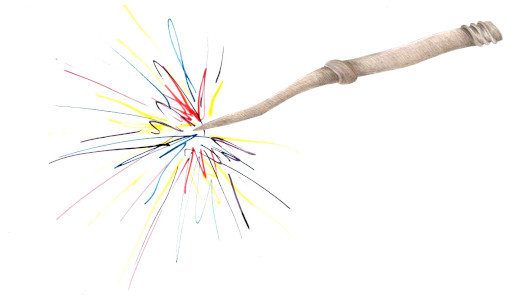Prompts
If TSDC workshop facilitators were magicians (they’re not — really!) prompts might well be their magic wand! We’ve discussed the role of prompts as a central tool (See TSDC’s Creative Approach) and will elaborate more on specific prompts when we talk about Story Circles, Image Theatre, and Post-Performance Activities. For now, here’s a brief recap: TSDC facilitators use prompts throughout different stages of the performance creation workshops (as well as in post-performance activities) to invite participants to imagine something which they are then asked to creatively express through storytelling, Image Theatre, a word or spoken phrase, an image or drawing.
To illustrate the role of prompts, let’s return to the magic wand analogy for a moment. As Harry Potter fans know, a wand is a tool for focusing and directing energy (similar to a concert conductor’s baton). The facilitator-as-magician uses their prompt-as-wand to channel what we might think of as creative-impulse spells. Each individual prompt works to focus specific exercise activities. Taken together, the overarching goal of the prompts is to assist the workshop participants in creating a play that communicates a fictionalized, collective, future-oriented story set in a public context.
Here’s an example of a getting to know one another activity and prompt that we used during a recruitment meeting with youth who were connected through Good Shepherd Youth Services. Everyone (including the community worker and members of the project’s creative team), was asked to find a partner (preferably someone they didn’t know too well). They were invited to introduce themselves to their partner by saying their name and describing to one another what the handbag (or knapsack, or carryall) they most often carry looks like. Then, the facilitator gave this prompt:
Your handbag or knapsack has seen the places you go in Hamilton.
If your bag could talk, what would it say?
In addition to being a playful way to do introductions, the prompt facilitated a creative experience that engaged three of TSDC’s key concepts: Having participants take on the voices of their bags invites them into a process of fictionalization, and asking them to tell us what their bags have seen about a shared public environment (Hamilton) invites them to create a collective story.
![]()
What we had no idea of at the time, was how central the idea of traveling through the City would end up being to the story arc of the play they created about a group of youth who frequently cross paths on a bus travelling the “Choose Your Destination” route.
Using prompts to initiate workshop activities:
- Helps focus the group’s collective imagination, which is particularly important in a time-limited performance creation workshop process.
- Provides a performative way of introducing participants to the four core elements — fictional, collective, future-oriented, and public — of TSDC’s performance creation process.
- Gives participants a chance to shape a story, image, or response in their imaginations prior to sharing out loud or expressing it through the creation of an embodied still image in workshops.
- Aids in generating material and in filling in missing pieces or gaps in the dramatic composition that is emerging.


